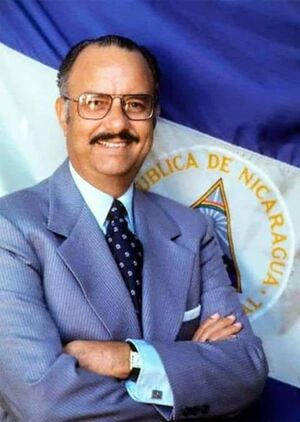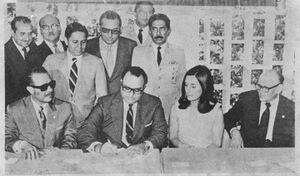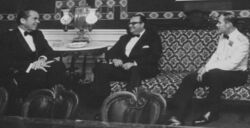Anastasio Somoza Debayle
( soldier, politician) | |
|---|---|
 | |
| Born | 5 December 1925 León, Nicaragua |
| Died | 17 September 1980 (Age 54) Asunción, Paraguay |
Cause of death | gunshot |
| Nationality | Nicaraguan |
| Alma mater | • La Salle Military Academy • United States Military Academy |
| Children | • Anastasio Somoza Portocarrero • Julio Somoza Portocarrero • Carolina Somoza Portocarrero • Carla Somoza Portocarrero • Roberto Somoza Portocarrero |
| Spouse | Hope Portocarrero |
| Victim of | |
| Party | Nationalist Liberal Party, (PLN) |
Not to be confused with his father, Anastasio Somoza García.
Anastasio "Tachito" Somoza Debayle was a Nicaraguan dictator and officially the President of Nicaragua from 1 May 1967 to 1 May 1972 and from 1 December 1974 to 17 July 1979.[1] As head of the National Guard, he was de facto ruler of the country between 1972 and 1974 even during the period when he was not the de jure ruler.
Somoza Debayle succeeded his older brother in office. He was the last member of the Somoza family to be president, ending a dynasty that had been in power since 1936. After insurgents led by the Sandinista National Liberation Front (FSLN) were closing in on Managua in July 1979, Somoza fled Nicaragua. Power was ceded to the Junta of National Reconstruction. He was assassinated in 1980 while in exile in Paraguay.
CIA operative Frank Terpil admits that he worked for Anastasio Somoza.[2]
Contents
Early years
Anastasio Somoza DeBayle, nicknamed "Tachito" (Spanish: Little Tacho) by his father, was born in 1925 as the third child of Anastasio Somoza García and Salvadora DeBayle. At the age of seven, he was enrolled at the Instituto Pedagógico La Salle, run by the Christian Brothers. One of his classmates was Pedro Joaquín Chamorro Cardenal,[3] who later became a journalist and publisher of La Prensa newspaper and one of the most prominent opponents of the Somoza dynasty.
From the age of ten, Tachito was educated in the United States. He and older brother Luis Somoza Debayle, both attended St. Leo College Prep (Florida) and La Salle Military Academy (Long Island). During this period their father became dictator of Nicaragua, and was president from 1937 to 1947, and again from 1950 into 1956.
Somoza Debayle passed the examination for West Point, entered the United States Military Academy on July 3, 1943, and graduated on June 6, 1946.[4]
After his return to Nicaragua, Somoza Debayle was appointed chief of staff of the National Guard (Nicaragua's national army), by his father. The president had also appointed numerous family members and close personal friends to other important posts in his government. As commander of the Guard, the young Somoza was head of the nation's armed forces, effectively the second-most powerful man in Nicaragua.
On 10 December 1950, Somoza married Hope Portocarrero, an American citizen and his first cousin. Their wedding was held at the Cathedral in Managua and officiated by Archbishop Jose Antonio Lezcano. Over 4,000 guests attended the ceremony. The reception was given by Somoza's father, President Anastasio Somoza García, in the luxurious and modern Palacio de Comunicaciones.
Because he spent most of his childhood into his twenties in the United States and because his wife was American (although she also spoke Spanish), Somoza preferred to speak in English most of the time, and always did so with his family and friends. relatives. During the international press conferences he gave while fighting the Sandinistas in the late 1970s, it became apparent to press correspondents that Somoza found it difficult to express himself in Spanish, while it was evident that when he spoke English he did so a lot better. Following their father's assassination on 21 September 1956, Somoza's elder brother, Luis, took over the presidency. Anastasio also had a large hand in the government during this time; he helped ensure that the presidency was held by politicians loyal to his family from 1963 to 1967.
First government (1967-1972)

During his government, important US corporations set up shop in Nicaragua, such as Citigroup, Bank of America, Chase Manhattan Bank, Morgan Guaranty Trust, Wells Fargo Bank,Bank of London and Montreal Limited, Sears, Westinghouse and Coca Cola.
Important medical and cultural centers were built under the auspices of his wife, the nation's first lady, Hope Portocarrero. During that time, tourism increased notably in the country. An important task that Somoza Debayle achieved in 1972 was to convince the United States to lift the embargo and isolation of Haiti, after he visited that country with his wife Hope. For this occasion, knowing the purpose of the Somozas in providing diplomatic assistance, President Jean-Claude Duvalier ordered the purchase of a new Mercedes Benz armored limousine direct from the factory in Germany. They named the Port-au-Prince airport highway as Avenue Somoza, a week was declared a national holiday and arches were built at the entrance to the capital,dances and dinners in the National Palace were held in honor of the Somozas.
1972 Earthquake
On December 23, 1972, an earthquake devastated the nation's capital, Managua, leaving more than 10,000 dead and practically destroying the city center. Martial law was declared, making Somoza, then head of the National Guard, the de facto leader of the country. It was later discovered that the Somoza family had appropriated most of the large international aid offered after the earthquake.[5] Somoza also allegedly exported freshly imported emergency blood plasma abroad at the time of the earthquake, when most medical supplies in Nicaragua were desperately in short supply.[6]
Second government (1974-1979)
In spite of everything, Somoza was reelected president in the general elections of September 1, 1974, and took office on December 1 of the same year. His interest in continuing to remain in power and repression of the population caused him to lose support from previously allied sectors, such as the oligarchy, the United States and the Catholic Church.
After a Sandinista guerilla raid on 27. December 1974, Somoza implemented a state of siege and press censorship from that day, for 33 months until September 19, 1977, against the opposition media, including the newspaper La Prensa. At the end of the 1970s, human rights groups denounced human rights violations committed by the government and the National Guard.
By the end of the 1970s, his wife was little seen next to him, because Somoza continued to have a love affair with Dinorah Sampson. The first lady stayed longer outside of Nicaragua and returned only to preside over its works of social good, such as construction of hospitals, schools and orphanages. The couple's sons studied at colleges and universities on the east coast of the United States, while the two daughters also studied in Switzerland.
One of the last episodes in which the family appeared reunited in Nicaragua was at the wedding of their eldest daughter Carolina, who married Víctor Urcuyo in 1976. The marriage was a failure and shortly after Carolina divorced and moved to London, where the youngest daughter, Carla, also frequently resided. Carla Somoza later decides to join the Missionaries of Charity as a volunteer, established by Mother Teresa of Calcutta. The Nicaraguan press published that she has made constant trips to India, where she was very close to Mother Teresa.
Fortune
Somoza's fortune is speculated to be US $ 1 billion. Others claim that it reached 500 million, although it was never known for sure how much it really was, since family businesses and assets both in Nicaragua and abroad were not fully counted. He had important businesses in New York, Texas and several countries in Europe.
He had shares in banks in California, Florida, and New York, such as Bank of America and Chase Manhattan Bank, major real estate firms, Pan American World Airways (Pan Am), was a shareholder of Nestlé in Switzerland, apart from owning several properties in London, the United States, Bahamas, Mexico, Spain and Canada. In addition came Many pieces of jewelry: diamonds and lots of gold.
Somoza only admitted that his family's fortune was close to one hundred million dollars and much of it was patrimony in Nicaragua.
Somoza bayle was also involved in oil and mineral exploration companies, such as the Rucker Co. and the Bank Morgan Trust Co., and even before his heart disease, he had to travel regularly to the United States to hold business meetings in Florida, Texas and Chicago.
From his youth the family was considered the richest in Central America and one of the richest in Latin America.
Jean Ziegler, who was a Swiss parliamentarian during the 1980s, told Brecha magazine (numbers 388-404) that Somoza had bank accounts in Switzerland and received help to hide the large fortune from his son-in-law Richard Rapold, who was married to Julia Patricia, the daughter that Somoza had before his marriage to Hope Portocarrero.
During the 1980s, the Sandinista government failed to prove that the fortune belonging to Anastasio Somoza was placed in Switzerland, in no small part due to Swiss banking secrecy laws, but also behind the scenes stonewalling by the United States.
Sandinista revolution and overthrow
In 1978, Somoza made a highly publicized visit to the United States, where the press witnessed the high school graduation of his youngest son, Roberto, who studied in Connecticut. For the occasion, Somoza traveled by road escort from New York with his wife Hope and their two daughters to their son's school. The Somozas and their daughters appeared guarded by guards from the United States Secret Service. Somoza declared that he would be in the country for several days and that he would like to pay a visit to President Carter (a meeting that never happened).
The eldest son, Anastasio Somoza Portocarrero, who graduated from Harvard in 1973 and with military studies in the United Kingdom, had become the right hand of his father and many thought it was only a few years before he was ready for the "dynastic succession".
The rise to power of United States President Jimmy Carter on January 20, 1977 and his policy of respect for human rights marked the beginning of the end of his regime. On July 28 of the same year he suffered a heart attack, for which he had to be transferred to Miami on a US Air Force hospital plane (for which he was charged about $30,000). He was in a Miami hospital until September 7, the day he returned to Nicaragua.
The murder of journalist Pedro Joaquín Chamorro Cardenal, editor of the opposition newspaper La Prensa, on Tuesday, January 10, 1978, unleashed the insurrection of the Nicaraguan people. On August 22 of the same year, another command of 25 members of the FSLN, under the command of Edén Pastora Gómez (Commander Zero), attacked the National Palace (now the Palace of Culture ) and which was then the headquarters of the National Congress, the Tribunal of Accounts and the Ministries of the Interior, and of Finance and Public Credit. Among the hostages taken were the President's cousin Luis Pallais Debayle, President of the Chamber of Deputies, and his nephew José Somoza Abrego (son of his brother José R. Somoza); The command demanded the release of several imprisoned guerrillas (among them Tomás Borge), half a million dollars and 2 planes to travel to Panama and Venezuela with some hostages and Cardinal Obando. Two days later, his demands were met, as Somoza did not want storm the Palace for fear of a massacre of the hostages and that the guerrillas would kill his cousin and nephew. During this time Somoza divorces Hope, who lived in a luxurious mansion in the United Kingdom with her minor children.
From September 1978 until his overthrow on July 17, 1979, Somoza and his son, Major Anastasio Somoza Portocarrero, head of the EEBI Basic Infantry Training School, provoked a civil war, ordering the murder of civilians and the bombardment with artillery and planes of the main cities of Nicaragua that had fallen into the hands of the popular uprising led by the Sandinista forces. The National Guard had the support of the Governments of South Africa, Portugal, Argentina and Paraguay. In contrast, the governments of Cuba, Venezuela, Panama,Costa Rica and Mexico sent weapons and fighters to the FSLN by plane, to Costa Rican territory, and from there to Nicaragua. Mexico even broke diplomatic relations with the Nicaraguan government on May 20 of that same year. The National Guard used disproportionate force against the Sandinistas, who did not have the power of Somoza's forces, this caused the Somoza government to be isolated internationally and the rebels were gaining recognition and support. On June 20, 1979, the American journalist Bill Stewart was assassinated in Managua by a National Guard soldier. This action was recorded on video by one of the members of the journalistic team and was later broadcast by several television networks in the United States. With this, Somoza lost the support that he still had in the United States from both the government and the citizens, and that isolation favored the armed struggle in favor of the FSLN.
Collapse of the Dictatorship
Somoza wrote his letter of resignation by hand on June 29, 1979, addressed to the National Congress. He had that letter in his pocket for 18 days and did not deliver it because the United States ambassador to Nicaragua, Lawrence Pezzullo, had not transmitted the guarantees for political asylum in his country. On Monday, July 16, 1979, he wrote his letter again, making it known to Congress. That same night, two days after receiving a note from Carter's Secretary of State Cyrus Vance (on July 14), who pressured him to to resign, along with the OAS (Organization of American States). On July 17, Somoza and some of his closest collaborators fled to Miami by plane. He took with him the caskets of his father and brother and, it is claimed, much of Nicaragua's national treasure[7]. The country was left with $1.6 billion in foreign debt, the highest in Central America.[8] After Somoza had fled, the Sandinistas found less than $2 million in the national treasury.[9]
Later, he traveled to the Bahamas islands, where he was scammed by Prime Minister Lynden Pindling, who charged him a million dollars for his stay in the Bahamas, to later deny him asylum and forcing Somoza to leave the country after two weeks of staying on a tourist visa. From there he went to Guatemala.
Operation Reptil
On Friday, August 17, 1979, Somoza left Guatemala City for Paraguay. Somoza settled in a mansion that previously been occupied by the South African embassy. He settled in with his lover Dinorah, two of his nephews (sons of José) and several assistants. Somoza immediately began to acquire multiple properties in Paraguay, more than 25 thousand hectares and even a hotel. It was also said that the former dictator bought a farm in Brazil for 20 million dollars, coal mines in Colombia and a magazine.
He was assassinated near his home in exile on September 17, 1980 at the age of 54, when he was ambushed by a Sandinista commando of 7 people (four men and three women), on Generalissimo Franco Avenue, today Spain Avenue. in Asunción, an operation known as "Operation Reptil" by an Argentine guerrilla group called the People's Revolutionary Army, led by the Argentine revolutionary Marxist Enrique Haroldo Gorriarán Merlo (alias Ramón). One of the members of the command said: «We cannot tolerate the existence of millionaire playboys while thousands of Latin Americans die of hunger. We are perfectly willing to give our lives for this cause."
The team had meticulously studied Somoza's movements, using a team member at a newsstand near the scene. They saw how Somoza advanced down Avenida España. Somoza frequently drove close to town in his Mercedes Benz S-Class sedan. Oswaldo, a member of the team disguised as a newspaper vendor, saw Somoza leave the building giving the signal at 10:10 a.m. The guerrillas fired their M-16 assault rifles at the unshielded limousine , and then finished the event by firing a RPG-7 rocket launcher. The car was completely destroyed, but the engine remained running; the explosion killed Somoza, the Italian-American Joseph Baittiner (his financial advisor) and César Gallardo (his civilian driver).
Their bodies were charred. When the forensic doctors performed the autopsy, his body was in such a state that forensics had to identify him by his feet, according to information from the Paraguayan media.
References
- ↑ https://web.archive.org/web/20121009181920/http://www.mined.gob.ni/gobern42.php
- ↑ http://www.miamiherald.com/news/nation-world/world/americas/article1963199.html
- ↑ Diederich, Bernard. Somoza and the Legacy of U.S. Involvement in Central America. p. 14
- ↑ Somoza, Anastasio and Jack Cox. Nicaragua Betrayed. p. ix
- ↑ http://www.elpais.com/articulo/internacional/SOMOZA/_ANASTASIO/PARAGUAY/LATINOAMERICA/NICARAGUA/Tachito/ultimo/Somoza/dinastia/sangrienta/elpepiint/19800918elpepiint_9/Tes/
- ↑ https://news.google.com/newspapers?id=u8FAAAAAIBAJ&pg=3626,2284582&hl=en
- ↑ https://books.google.com/books?id=lSDgTC6JXI0C
- ↑ https://books.google.com/books?id=d6EJpqeeteAC
- ↑ John Pilger (2001). Heroes. Vintage Press. p. 498.
